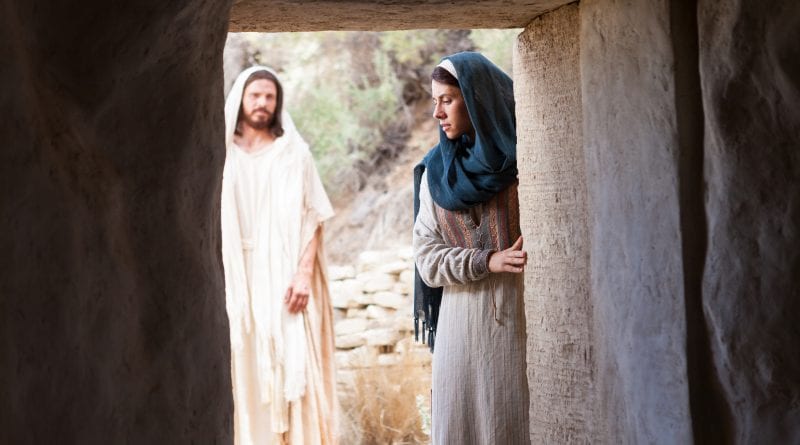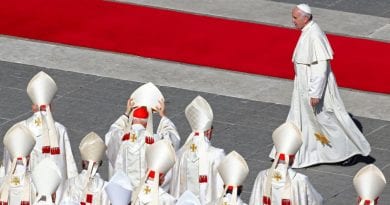Did Jesus visit his Mother first on Easter morning? “Probably so”
Originally Published at Aleteia.com
21 years ago, the Polish pope had this to say about Mary as witness to the Paschal mystery.
The Filipino community has a whole celebration linked to the traditional belief that the Resurrected Jesus must surely have chosen to visit His Mother first, even before Mary Magdalene saw him at the tomb.
This belief was reflected upon by Pope John Paul II at the general audience of May 21, 1997.
1. After Jesus had been laid in the tomb, Mary “alone remains to keep alive the flame of faith, preparing to receive the joyful and astonishing announcement of the Resurrection” (Address at the General Audience, 3 April 1996; L’Osservatore Romano English edition, 10 April 1996, p. 7). The expectation felt on Holy Saturday is one of the loftiest moments of faith for the Mother of the Lord: in the darkness that envelops the world, she entrusts herself fully to the God of life, and thinking back to the words of her Son, she hopes in the fulfilment of the divine promises.
The Gospels mention various appearances of the risen Christ, but not a meeting between Jesus and his Mother. This silence must not lead to the conclusion that after the Resurrection Christ did not appear to Mary; rather it invites us to seek the reasons why the Evangelists made such a choice.
On the supposition of an “omission,” this silence could be attributed to the fact that what is necessary for our saving knowledge was entrusted to the word of those “chosen by God as witnesses” (Acts 10:41), that is, the Apostles, who gave their testimony of the Lord Jesus’ Resurrection “with great power” (cf. Acts 4:33). Before appearing to them, the Risen One had appeared to several faithful women because of their ecclesial function: “Go and tell my brethren to go to Galilee, and there they will see me” (Mt 28:10).
If the authors of the New Testament do not speak of the Mother’s encounter with her risen Son, this can perhaps be attributed to the fact that such a witness would have been considered too biased by those who denied the Lord’s Resurrection, and therefore not worthy of belief.
2. Furthermore, the Gospels report a small number of appearances by the risen Jesus and certainly not a complete summary of all that happened during the 40 days after Easter. St Paul recalls that he appeared “to more than 500 brethren at one time” (1 Cor 15:6). How do we explain the fact that an exceptional event known to so many is not mentioned by the Evangelists? It is an obvious sign that other appearances of the Risen One were not recorded, although they were among the well-known events that occurred.
How could the Blessed Virgin, present in the first community of disciples (cf. Acts 1:14), be excluded from those who met her divine Son after he had risen from the dead?
3. Indeed, it is legitimate to think that the Mother was probably the first person to whom the risen Jesus appeared. Could not Mary’s absence from the group of women who went to the tomb at dawn (cf. Mk 16:1; Mt 28:1) indicate that she had already met Jesus? This inference would also be confirmed by the fact that the first witnesses of the Resurrection, by Jesus’ will, were the women who had remained faithful at the foot of the Cross and therefore were more steadfast in faith.
Indeed, the Risen One entrusts to one of them, Mary Magdalene, the message to be passed on to the Apostles (cf. Jn 20:17-18). Perhaps this fact too allows us to think that Jesus showed himself first to his Mother, who had been the most faithful and had kept her faith intact when put to the test.
Lastly, the unique and special character of the Blessed Virgin’s presence at Calvary and her perfect union with the Son in his suffering on the Cross seem to postulate a very particular sharing on her part in the mystery of the Resurrection.
A fifth-century author, Sedulius, maintains that in the splendor of his risen life Christ first showed himself to his mother. In fact, she, who at the Annunciation was the way he entered the world, was called to spread the marvelous news of the Resurrection in order to become the herald of his glorious coming. Thus bathed in the glory of the Risen One, she anticipates the Church’s splendor cf. Sedulius, Paschale carmen, 5, 357-364, CSEL 10, 140f).
4. It seems reasonable to think that Mary, as the image and model of the Church which waits for the Risen One and meets him in the group of disciples during his Easter appearances, had had a personal contact with her risen Son, so that she too could delight in the fullness of Paschal joy.
Present at Calvary on Good Friday (cf. Jn 19:25) and in the Upper Room on Pentecost (cf. Acts 1:14), the Blessed Virgin too was probably a privileged witness of Christ’s Resurrection, completing in this way her participation in all the essential moments of the Paschal mystery. Welcoming the risen Jesus, Mary is also a sign and an anticipation of humanity, which hopes to achieve its fulfillment through the resurrection of the dead.
In the Easter season, the Christian community addresses the Mother of the Lord and invites her to rejoice: “Regina Caeli, laetare. Alleluia!” “Queen of heaven, rejoice. Alleluia!” Thus it recalls Mary’s joy at Jesus’ Resurrection, prolonging in time the “rejoice” that the Angel addressed to her at the Annunciation, so that she might become a cause of “great joy” for all people.






I am deepling convinced that Jesus did first appeared to the Holy Mother. Years back, every time, when I heard the priests during the Mass commenting on the fact that Jesus appeared first to Mary Magdalena, my spirit was just unable to receive it; in the silence of my heart, I used to
say “No way, 100% sure that He first appeared to His mother”. One day, I believe I was led by the Lord Himself, I came across Maria Valtorta “The Gospel as revealed to me, which I knew not. And yes, I believe she was an instrument of God and, in that book, the Lord indeed first appeared to Our Lady, not at the tomb, and He even informed Her that He was going to see the “other Mary.”
Another thing that also used to trouble me was to hear some preachers (mostly Pentecostal
but I also heard from a Priest) saying that John the Baptist was jealous of Jesus (because he sent his disciples to ask Jesus if He was the One…), statement that I used to always reject and even found it a non sense. In the same book, I have the confirmation that John the Baptist has never doubted about Jesus. He just wanted some of his disciples, who were doubting or rather were scared that everyone was going to Jesus, to see by themselves Who Jesus was.
I also believe as said in this article, that Not everything is reported in the Bible concerning Jesus but Everything we need in order to be saved is there.
Blessings
In the True Life in God messages received by Vassula Ryden since 1985, we can observe the words of Jesus spoken to us all through Vassula that the closeness between Mother and Son cannot be denied. This will help us to believe that the immediate contact after the resurrection had already been established from the time of conception as there was a closeness only possible in the Devine Way.
Some quotes from the T.L.I.G. messages to back this up.
January 25-1988.
”My Mothers Immaculate Heart is united to Mine,”
November 9-1968. The crucifixion.
”My gaze fell on My Mother. I looked upon Her and Our Hearts spoke.”
March 25-1996. The birth of Jesus.
”The Redeemer of all mankind, The Promised Messiah came to the perfect image of
My Sacred Heart to share the sorrows, the joys, the sufferings, the martyrdom, the wonders, the betrayals, the agonies, the scourging, the piercing, and the crucifixion ;
together Our Hearts atoned.